W.J. Peall
PAST MASTERS No. 11 - January 1984
(Note: Additional photographs and information
have been added to the original article which are shown by the use
of italics.)
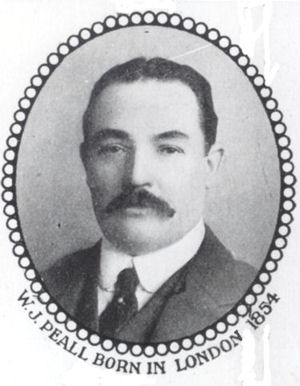
W.J. Peall, who lived to become the "grand Old
Man", of the game was born in St. Pancras, London, on 31st December
1854, and was 98 years of age when he died in June 1952. He was
some six years older than the famous John Roberts Junior, but
almost exactly the same age as his great friend and rival William
Mitchell (See Past Masters No. 10), who was born just a few weeks
earlier in October 1854, and like Mitchell he never held the
Championship Title - but was recognised as one of the leading
professionals of his day, and he was a member of the first
Committee of the Billiards Association, when the official rules
were first compiled in 1885.
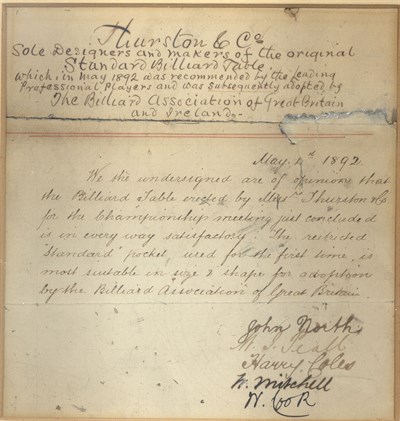
Note : the signatures for the Billiard
Association of Great Britain included not only W.J. Peall but also
W. Mitchell
(Past Master no.10) , J.North (Past Master
No.9)
The document is from the THURSTON files showing that their
table was selected as "The Standard Billiard Table" in
1892.
Like nearly all the professionals, he started young - first
playing the game, according to his own report extracted from the
"Billiard Player" of September 1939, when only 14 years of age. His
father was the owner of the Clarendon Hotel at Camberwell, where he
had every opportunity to play on the billiard table, and could give
the visitors long starts. He gave up the game for a number of years
returning to it at the age of 23. He had benefited by having
lessons from John Roberts Senior, and for over 50 years used a cue
which he received from him.
In 1880 at the age of 26, he issued a challenge to any other
amateur in the world to play a game of 1000 up intending to play
permanently as an amateur, but, as the result of playing in a
Professional Tournament during 1880, although he had stipulated
that if he won he would forfeit the prize money. In fact, although
he received no money, he was adjudged a professional by the press
on the grounds that he had taken part in a Tournament where gate
money had been charged, and prize money awarded. This seems to have
settled his status for him. He was not very pleased about it,
saying that …"As an amateur he was a somebody, but as a
professional he had a great chance of being a nobody amongst all
the great professionals then playing" … However he accepted the
situation with good grace, an attitude he always displayed
throughout his long career.
He practised the "spot stroke", until he became the greatest of
all spot stroke players. Some thought he "invented" the stroke, but
although he undoubtedly perfected it, the stroke was actually
played by the very first professional Jonathan (Edwin) Kentfield,
long before Peall was born.
Major Broadfoot, in the Badminton Library Series reports that
Peall made his first appearance as a professional in 1880 at the
Royal Aquarium, but that due to lack of confidence, he did not put
up a very good performance. However in May 1884 at the Aquarium, he
beat Mitchell easily, taking only 44 minutes and 4 breaks to score
1000 points. Shortly afterwards at Cambridge, again playing against
Mitchell, he made a break of 1989 points (including 548 consecutive
spot strokes). This break however was not recognised as he had
already run out a 411, so most of the break was achieved after the
game was over.
In an "all in" game (i.e. push and spot strokes permitted)
against Roberts, at the Aquarium during May 1884 Peall, who
received 2000 points in 10,000 up, won by 589. Following this
success Peall offered to play anyone except John Roberts and W.
Mitchell 5000 up evens for £100 or £200 a side (remember in present
day money value this would be equal to about the sum of
£6,000/12,000!), but nobody accepted the challenge.
Interest in Billiards declined somewhat at this period of time
and there were no matches for the Championship during the three
years 1886/7/8, although there were a number of matches played for
what Major Broadfoot describes as, "more or less fictitious
purses". However he records that in 1886, Peall challenged the
Champion John Roberts Junior to play a match of 15,000 up "all in"
on even terms, but Roberts declined the offer then and whenever it
was repeated and so Major Broadfoot considered that Peall was then
entitled to claim the Championship.
Peall's achievements during his professional career included
eight breaks over 2000 and 49 breaks over 1000. It is recorded by
Charles Dawson in his book "Practical Billiards", that during one
week in March 1888, whilst playing against Mitchell for the "Spot
Stroke" Championship, Peall won easily by 15,000 points to
Mitchell's 6,753 making breaks of over 1000 on every day except
Thursday during the week.
During the Spot Stroke Championship of the following year 1889,
the Tournament again resolved itself into a fight between Mitchell
and Peall, when shortly after the start, with the scores standing
at Mitchell 13 and Peall 20, Mitchell secured position and ran out
with a break of 987.
Peall and John Roberts both recognised that under these
circumstances the "Spot Stroke" was doing great harm to the game,
as spectators were not willing to pay in order to watch very long
runs of exactly similar shots. Roberts changed the trend by
introducing the "spot barred" condition. This however was to
Robert's own advantage, as Peall remarked in an interview reported
in the "Billiard Player" of August 1939, that …. "Roberts could
then give any of us a third of the game start and win"….
The spot stroke however was not barred by the official rules
until 1898, and so the "all in" game was played for another 9
years. As a result in March 1889, during a match at the Aquarium
between Peall and White, three breaks of over 1000 (two by White
and one by Peall), were made during one day's play, and two days
later in the same match, three consecutive breaks of over 1000 were
made (two by Peall and one by White).
Peall was undoubtedly the master of the "spot stroke", during
this period. Playing against Dawson at the Aquarium in November
1890 and giving Dawson 3000 points start in 10,000 up, he made a
break of 3304 points all within the game, and thus recognised as a
record. This break included spot stroke runs of
93-3-150-123-172-120 and 400! Peall winning by 9320 points, and
poor Charles Dawson had found himself sitting out as a spectator
for 1 ½ days without playing a stroke.
In the Association Tournament played in December 189 - the "spot
and push" strokes were barred. The effect of this condition was a
great handicap for Peall, who after a determined struggle was
beaten by J. Lloyd.
The spot stroke had become a practical proposition as the
principal scoring stroke when the Billiards Association, which was
established in 1885, abolished the 3" pocket and substituted the
present day standard pocket opening. This had given Peall his
opportunity, and his overwhelming superiority at this stroke
prevented others from accepting his challenges, but his supremacy
disappeared completely when the stroke was abolished in October
1898. But he never complained, indeed he had previously recognised
the damage caused to spectator interest.
During 1895/6, Peall became involved in running arguments with
John Roberts over the fitting of pneumatic cushions to billiard
tables. As will be seen from the short extract taken from the
abbreviated list of Patents & Inventions registered in 1890
relating to games, the "Pneumatic Cushions" were in fact invented
by a Mr A.A. Toomey - it would seem that a puncture outfit would
need to be an essential part of the billiard room accessories.
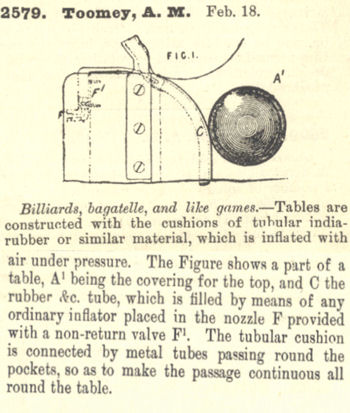
Both Roberts and Peall had taken up an interest in the Billiards
Trade, Roberts was interested in marketing pneumatic cushions, and
a number of letters were published in the "Sportsman", about the
advantages and disadvantages claimed by Peall and Walder, in favour
of their frost proof cushions, and replies by John Roberts
defending his pneumatic cushions which culminated in a letter from
John Roberts and Company, dated 10th January 1896, which concludes
…. "If Peall and Walder can satisfy Mr. Roberts that their cushion
is superior, we shall be pleased to adopt it…. We shall only use
the pneumatic cushion for so long as we consider it to be the best
cushion available". The players even ended up challenging each
other to play a match - one week on a table fitted with Peall and
Walder frost proof cushions, and one week on a table with Robert's
pneumatic cushions. As readers will realise the pneumatic cushion
was not successful and has long since disappeared.
During my researches into the career of Mr Peall, one or two
interesting bits of information have come to light viz:-
It seems that Mr Peall was one of the first enthusiastic owners
of a motor car, possessing several different models from time to
time. So it was that on Saturday 14th September 1901 driving in
open country near Redhill, he was stopped by police and
subsequently charged and fined £2, for driving at a speed in excess
of 12 mph, having been timed at approximately 15 ½ mph!
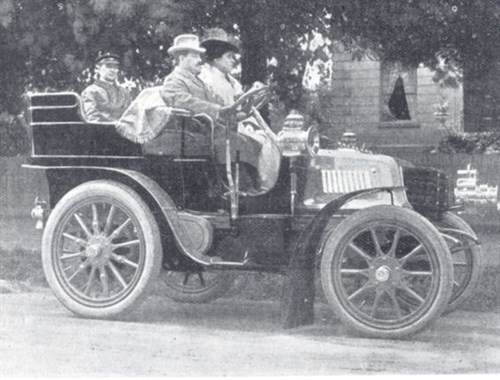
From The World of Billiards June
1920. In which it was reported -
"Lately, at the great meet at
Bexhill-on-Sea, Mr. Peall gained the prize for the most elegant car
taking part in the festival. Annexed is the photograph of the
winning motor car, with Mr. Peall at the helm""
In May of 1912, it was reported in
the "Billiard Monthly" that Mr. Peall Senior and Mr Peall Junior,
had played in a charity match to raise funds for the victims of the
Titanic disaster.
Finally, something during 1942/3, whilst the writer was
C.S.M.(Company Sergeant Major) of No. 3 Company of the Headquarters
Training Establishment R.E.M.E. (Royal Electrical & Mechanical
Engineers) at Arborfield, a certain Sgt. Peall arrived with an
intake of trainees at the Company Office. On giving his number,
rank and name, C.S.M. Clare remarked …."Peall - that is an uncommon
name - are you by chance related to the well known billiard
player?"
The answer was "yes I am his grandson". Unfortunately the
autographed photograph brought back from Sgt. Peall's weekend leave
has been lost.
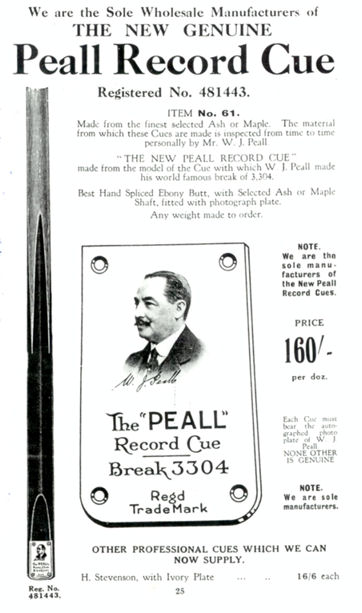
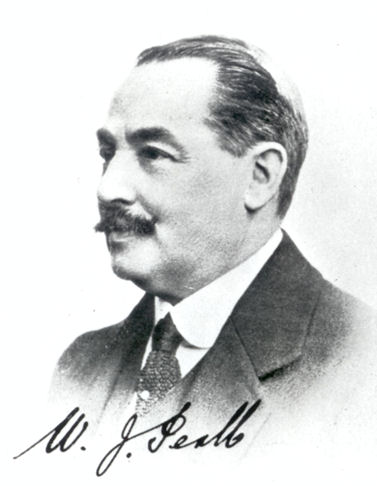
The advert using the above signed picture is from the
MacMorrans Cue catalogue 1933/34.
Note:- The MacMorrans company
was taken over by the famous cue makers Peradon (see the Peradon story
inHistories & Articles) in 1958. Norman Clare became Chairman
of the Peradon when it became part of the E.A. Clare
Group.
**********************
© Norman Clare 1990. © E.A.
Clare & Son Ltd. 2018.
Reproduction of this article allowed only with the permission from
E.A. Clare & Son Ltd.
Please do not hesitate to contact Thurston for any advice on
snooker, billiard or pool or wish to make a purchase. Thurston has
the most comprehensive range of tables and accessories available
see our
e-shop - www.thurston.co.uk
email thurston@eaclare.co.uk
Phone - 0870 607 1336

